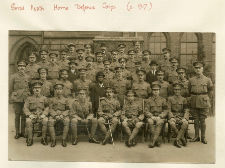Resources
A Black Volunteer in Birmingham’s WWI, Small Heath
On 17, Dec 2015 | In Resources | By Nicola Gauld
Back when I was working in Birmingham Central Library on a wide range of heritage projects, a lot of my time was spent researching city collections that hadn’t been used or looked at for many years.
Now and again, newspaper clippings and miscellaneous albums containing fragments of civic ephemera, photographs and leaflets would reveal unexpected stories. One of my favourite discoveries was this picture of The Small Heath Home Defence Guard, circa 1917 (Birmingham Archives & Heritage, Birmingham Scrapbook, vol. 10). It was pasted into a large volume with virtually no other information. Nevertheless, this small image says a lot about WWI era Birmingham.
Most of these men appear to be of an age where they would not have been eligible for service in France. However, their expressions leave us in no doubt as to the seriousness with which they took part in this home defence group. Each army uniform would have been bought by the individual member; regulation arm bands signalled their ‘volunteer’ Home Guard status. All these men were very likely to have worked somewhere within the industrial Small Heath landscape. But what were their names? How well did they know each other? Where exactly was the photograph taken?
An incredibly important feature of the image is the startling presence of a Black volunteer within the ranks. Who was this man and why did he feel compelled to sign up for the Small Heath volunteers? His central positioning within the visual frame and the fact he wears no uniform are all very interesting features that could be greatly speculated over. The whole image brings together a vividly powerful yet dramatically elusive visual commentary on histories of race, diaspora, class and empire embedded within Birmingham during the Great War.
Fascinatingly, a later separate picture of the R.W.R Small Heath 5th Volunteer Battalion dated March 16th, 1919 appears to feature the same figure standing on the back row of a much larger photograph, this time in full volunteer uniform. Again, he is the only Black figure in the proud gathering of Small Heath men. Luckily, this time the picture contained a key to the image bearing a list of names. The figure in the photograph could now at least be identified as ‘F. Johnson’. For a number of years, this was the limits of our knowledge about him. However, as more and more stories about WWI emerged over the last year, the memory of F. Johnson’s picture stayed with me.
Recently digging out some research papers from my days at Central Library, once again I came across F. Johnson’s portrait. Joining the Imperial War Museum’s website dedicated to Lives of the First World War, I began randomly exploring the 1911 ‘street census’ entries, wondering if it might be worth having yet another look to see if I could find an F. Johnson in the city. Years ago, I’d spent hours on the same fruitless search. Yet as any researcher knows, the past is elusive; it can take many attempts to find or understand what was there all along.
This time, I was lucky enough to discover something. On the local 1911 census, it turns out there is a compelling entry: 123 Whitehall Road, Small Heath: ‘Frederick Johnson, boarder, 48 years old, single, occupied as a (trams?) Painter, employed by Council, born Kingstown (sic), Resident of Jamaica, West Indies’. Two other people live in the property: Head of the household is given as Sarah Jones, 58, Widow, (born Warwickshire); and Frederick Jones, her son, 30, Railway Porter, (born Warwickshire).
With this step forward, I’m glad we now know more about Frederick Johnson. I’m also sure that after unearthing this new evidence, much more could be done with his story. What happened to Frederick after the war? And who was the Sarah Jones that gave lodgings to a man from Jamaica many years before issues of a racist colour bar reared their head in Birmingham’s post Windrush era?
Very recently, I published a book of poems about my experiences of working with Birmingham cultural archives and the challenges of engaging with fragments of memory from which we assemble our ever-changing understandings of the past. The book went to print before I was able to feature Johnson’s story, but the on-going journey to discover more about his life reminds me of a line included in its preface: ‘Archives are keys to lost cities where unheard voices wait to speak’.
Dr Andy Green
‘These Notes Are Out Of Order’ is published through the Shoestring Press.
http://www.shoestring-press.com/2015/09/these-notes-are-out-of-order/
For more WW1 information and images from the Birmingham Archives collection please see ‘The shadow of war’ by Rachel MacGregor on The Iron Room blog
https://theironroom.wordpress.com/2014/10/30/the-shadow-of-war/



